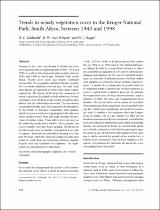 ResearchSpace
ResearchSpace
Trends in woody vegetation cover in the Kruger National Park, South Africa, between 1940 and 1998
JavaScript is disabled for your browser. Some features of this site may not work without it.
- ResearchSpace
- →
- Research Publications/Outputs
- →
- Journal Articles
- →
- View Item
| dc.contributor.author |
Eckhardt, HC

|
|
| dc.contributor.author |
Van Wilgen, BW

|
|
| dc.contributor.author |
Biggs, H

|
|
| dc.date.accessioned | 2007-06-29T07:43:20Z | |
| dc.date.available | 2007-06-29T07:43:20Z | |
| dc.date.issued | 2000-06 | |
| dc.identifier.citation | Eckhardt, HC, van Wilgen, BW and Biggs, H. 2000. Trends in woody vegetation cover in the Kruger National Park, South Africa, between 1940 and 1998. African Journal of Ecology, vol. 38(2), pp 108-115 | en |
| dc.identifier.issn | 0141-6707 | |
| dc.identifier.uri | http://hdl.handle.net/10204/740 | |
| dc.description | Copyright: 2000 East African Wild Life Society | en |
| dc.description.abstract | South Africa’s Kruger National Park is one of the largest conservation areas in Africa. In 1940, 1974 and 1998 changes in the cover and density of shrubs and trees were assessed from aerial photographs, and in 1984 and 1996 fixed-point photographs were taken from the park. Woody cover (trees and shrubs combined) increased by 12% on granite substrates but decreased by 64% on basalt substrates over the past 58 years. Both these figures are expressed in terms of the initial values, respectively. The density of the large tree component of woody vegetation decreased on both substrates. Woody vegetation cover declined as fire return periods became shorter, but the relationship was weak. The increases in woody plant density and cover on granite are thought to be the result of decreased competition from grasses, which in turn is a result of overgrazing by wild herbivores whose numbers have been kept high through the provision of surface water. These effects were not seen on the relatively nutrient-rich basalts, where grasses can recover rapidly even after heavy grazing. The decline in overall woody cover on basalts is interpreted as a result of regular, short-interval prescribed burning over the past 40 years, while the universal decline in large trees seems to result from an interaction between regular, frequent fires and utilization by elephants. | en |
| dc.language.iso | en | en |
| dc.publisher | East African Wild Life Society | en |
| dc.subject | Woody vegetation | en |
| dc.subject | Photographs | en |
| dc.subject | Kruger National Park | en |
| dc.subject | Vegatation cover depletion | en |
| dc.subject | South Africa | en |
| dc.subject | Environmental sciences | en |
| dc.title | Trends in woody vegetation cover in the Kruger National Park, South Africa, between 1940 and 1998 | en |
| dc.type | Article | en |
| dc.identifier.apacitation | Eckhardt, H., Van Wilgen, B., & Biggs, H. (2000). Trends in woody vegetation cover in the Kruger National Park, South Africa, between 1940 and 1998. http://hdl.handle.net/10204/740 | en_ZA |
| dc.identifier.chicagocitation | Eckhardt, HC, BW Van Wilgen, and H Biggs "Trends in woody vegetation cover in the Kruger National Park, South Africa, between 1940 and 1998." (2000) http://hdl.handle.net/10204/740 | en_ZA |
| dc.identifier.vancouvercitation | Eckhardt H, Van Wilgen B, Biggs H. Trends in woody vegetation cover in the Kruger National Park, South Africa, between 1940 and 1998. 2000; http://hdl.handle.net/10204/740. | en_ZA |
| dc.identifier.ris | TY - Article AU - Eckhardt, HC AU - Van Wilgen, BW AU - Biggs, H AB - South Africa’s Kruger National Park is one of the largest conservation areas in Africa. In 1940, 1974 and 1998 changes in the cover and density of shrubs and trees were assessed from aerial photographs, and in 1984 and 1996 fixed-point photographs were taken from the park. Woody cover (trees and shrubs combined) increased by 12% on granite substrates but decreased by 64% on basalt substrates over the past 58 years. Both these figures are expressed in terms of the initial values, respectively. The density of the large tree component of woody vegetation decreased on both substrates. Woody vegetation cover declined as fire return periods became shorter, but the relationship was weak. The increases in woody plant density and cover on granite are thought to be the result of decreased competition from grasses, which in turn is a result of overgrazing by wild herbivores whose numbers have been kept high through the provision of surface water. These effects were not seen on the relatively nutrient-rich basalts, where grasses can recover rapidly even after heavy grazing. The decline in overall woody cover on basalts is interpreted as a result of regular, short-interval prescribed burning over the past 40 years, while the universal decline in large trees seems to result from an interaction between regular, frequent fires and utilization by elephants. DA - 2000-06 DB - ResearchSpace DP - CSIR KW - Woody vegetation KW - Photographs KW - Kruger National Park KW - Vegatation cover depletion KW - South Africa KW - Environmental sciences LK - https://researchspace.csir.co.za PY - 2000 SM - 0141-6707 T1 - Trends in woody vegetation cover in the Kruger National Park, South Africa, between 1940 and 1998 TI - Trends in woody vegetation cover in the Kruger National Park, South Africa, between 1940 and 1998 UR - http://hdl.handle.net/10204/740 ER - | en_ZA |





